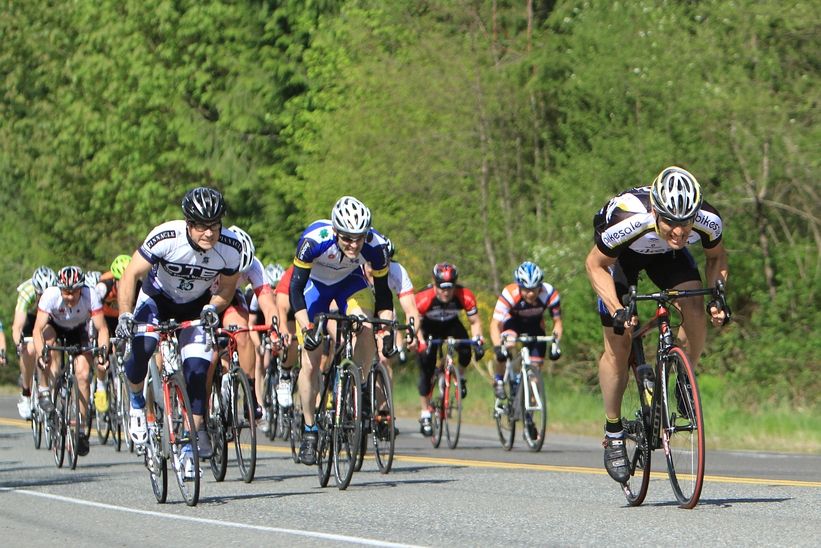The more I ride the more gratification I want out of it. I want to kill it better than I did before and it never fails that I will not think of another idea to help me get there. Racing this season rolled-off to a decent start with the Frozen Flatlands, an early season opener typically in lousy weather conditions, and Ronde Von Palouse, a Paris-Roubaix style course that thoroughly kicked my butt up, down, and sideways. I say decent because this time around I was able to move from the off-season and into the campaign without the job and “life” getting in the way too much. As it turns out, the smooth start was a feint and life threw me a right-hook, but that’s another story.
I thought of this idea during the off-season to help me focus my intensity training as the season developed. I’ve asked myself many times, “What does my training intensity need to be in order to be successful in a particular race?” My idea was to compare racing intensity to training intensity so that the difference could be determined, and the training plan revised. In this example I want to examine a particular course feature under racing circumstance so that I can fashion my training to improve upon it.
Another thought: This method is foundational and temporary. Owners of a wireless PowerTap and a Garmin Edge 500 already have the wattage data correlated with the topographical data. (The Edge 500 is my next purchase after I finish my front wheel-build.) I expect that learning the wattage and time span associated with a particular topographic feature would be easier than the method discussed here.
The purchase of a PowerTap SL+ was pivotal for effective training in my opinion. You don’t know if you don’t measure. Indeed, anything else is just guessing. I believe it was money well-spent. Nonetheless, being able to measure racing intensity was half of this issue. I was able to gather the race data from a particular course last season—a course called “Corsa Brutale.” It’s one of my favorites here in the Inland Northwest composed of flats, winding downhills, rollers, and climbs. The distance is shorter comparably (~24 miles) with a net 961 foot ascent. Wattage, cadence, heart rate, speed, distance, and torque are all recorded within the data file as observed with the free PowerAgent software. The course is short and fast. Here’s what the layout and elevation profile look like:

Figure 1. Corsa Brutale course map (the climb in Fig. 2 highlighted in gray)
Note that the green cursor in the map view corresponds with the gray section locator in Figure 1. This is the subject I’m concerned with and is one of the tactical features of this course. Why the concern? First, it’s right in your face, just five miles into the course before everyone is out of the saddle and blasting up the slope. Second, attacking at the false top (see mile marker nine) for a breakaway advantage is a given on this course. Staying at the front to observe and jump with the break is a must. How much wattage and duration is needed to do this? That my dear reader, is the whole reason for this post.
Let’s look at the wattage expenditure for this little climb.

Figure 2. Wattage vs. Distance
By the way, you might notice that the map has the climb starting after mile four, while the power profile begins around the ten-mile mark. Explanation: I rode my bike to the race course and had started my data recording then—my mistake. That’s about six miles. Starting from the left, we’re in the pack already on the rise towards the steeper portion. Speed starts to decline as the pack meets the increasing slope. Wattage starts to rise in order to stay with the front. At about 10.3 miles, we’re near 300 Watts just to hang-on and watch for any attack to take place.
Using the windowing feature within the PowerAgent software, we’re able to determine the duration for this portion of the course. In this case it’s about a minute. So, we have determined conservative measures of intensity (300 W) and duration (1 minute) from a tactical portion of the course under racing conditions. If we use the usual format to structure this training interval, it might look like this:
| Repetition | Interval time | Recovery time |
|---|---|---|
| 6 | 1 minute @ 300W | 2 minutes |
Edit: 6/28/2011. I finished another race on this course yesterday. This latest data file indicates that this feature of the course was 2 minutes, 11 seconds at an average of 405 W to stay with the front of the pack.
You’ll have to decide the number of repetitions based on your level of fitness. Be sure to include a warm-up and cool-down portion too. Eventually, I’d look at the whole race profile to determine the number of significant climbs, and the wattage and duration associated with them. You can choose to make sets of repetitions or do them repetitively. Use your creativity to keep you training and avoid mental burnout. Whatever routine you decide on still adds-up to the same end—your body as a system receives the cumulative impulse, and responds (during and after recovery) with the appropriate increase in strength (or capability).
By the way, you can create interval sessions within PowerAgent from scratch or you can derive them from a particular data file. There’s some data input or screening you’ll have to decide on, but not too much different from what we’re doing in this post. I don’t use the data file derivation method because it’s blind to what I consider to be the tactical nature of this analysis.
I’m going to try this method to goal-orient my intensity training. While I’ll be working on increasing my functional threshold power (FTP) for overall improvement, I also want to add the capacity for intensity. In this manner, I can have more capability available to me during a particular race, i.e. I’ll have more matches in my matchbook.
Hope you found this idea interesting. Keep ’em rolling!







Recent Comments: